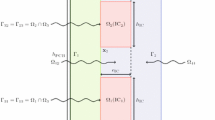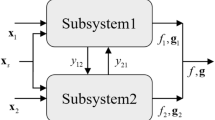Abstract
Reliability-based design optimization (RBDO) utilizing computer simulations can lead to a highly reliable optimum design. However, conventional RBDO methods require full statistical information of input variables to estimate reliabilities of engineering systems or components, which is not easy to obtain in most engineering applications. In this paper, an uncertainty quantification method with mean-correlated simulations is proposed to estimate the statistical information of input variables from corresponding system response distributions obtained using large-scale test database. The proposed approach employs an error-lumped inverse method and kernel density estimation (KDE) for the uncertainty quantification. All possible errors such as measurement error, simulation error, and error by input variable difference are lumped into one to minimize residual errors of responses. Because quantified uncertainties using the error-lumped inversed method could be too scattered, distribution correction is proposed to reduce effective range of input variables while maintaining response distributions. Numerical and engineering examples show that the proposed approach can well estimate uncertainties of input variables using mean-correlated simulation and system response distributions obtained from test results.
















Similar content being viewed by others
Abbreviations
- A f :
-
Overlapped area of two probability density functions
- b :
-
Bandwidth for kernel density estimation
- E :
-
Elasticity of cantilever beam
- e :
-
Lumped error of system response for single-input and single-response physics
- e min :
-
Minimum value of e.
- e i :
-
Lumped error of ith system response
- e m :
-
Measuring error of system response for single-input and single-response physics
- \( {e}_i^m \) :
-
Measuring error of ith system response
- e s :
-
Simulation error of system response for single-input and single-response physics
- \( {e}_i^s \) :
-
Simulation error of ith system response
- e UF :
-
Geometrically averaged error of system responses
- \( {e}_{UF}^{\mathrm{min}} \) :
-
Minimum value of eUF
- F b :
-
Fin buckling force of heat exchangers
- \( {F}_b^r \) :
-
Required specification of fin buckling force for product design
- F p :
-
Fin density of heat exchangers
- F x :
-
Axial force of cantilever beam
- F y :
-
Vertical force of cantilever beam
- f(x):
-
Probability density function of variable x
- \( \hat{f}(x) \) :
-
Probability density function of variable x calculated from kernel density estimation
- h(x):
-
Response simulator of system for single-input and single-response physics
- h i(x):
-
Response simulator of ith system
- K(•):
-
Kernel function for kernel density estimation
- L :
-
Length of cantilever beam
- M :
-
Number of simulators
- N :
-
Number of samples
- n :
-
Exponent of Af which amplifies validation metric for more detailed comparison
- P f :
-
Failure probability
- \( {P}_f^{\ast } \) :
-
Failure probability using the assumed uncertainty as Gaussian distribution
- \( \dot{Q} \) :
-
Heat dissipation of heat exchangers
- \( {\dot{Q}}^r \) :
-
Required specification of heat dissipation for product design
- S j, 0 :
-
Initial effective range of jth variable
- S j, α :
-
Effective range of jth variable with significant level α
- T :
-
Thickness of cantilever beam
- V :
-
Validation metric
- V α :
-
Validation metric with significant level α
- V α(δ):
-
Validation metric of deflection with significant level α
- V α(τ):
-
Validation metric of stress with significant level α
- V α(ω):
-
Validation metric of first natural frequency with significant level α
- \( {\overline{V}}_{\alpha } \) :
-
Averaged validation metric of Vα(δ),Vα(τ), and Vα(ω)
- W :
-
Width of cantilever beam
- w j(•):
-
Weight function for probability distribution function of jth input variable
- x :
-
Exact value of input variable for single-input and single-response physics
- x j :
-
Exact value of jth input variable
- \( {x}_j^{LB} \) :
-
Lower bound of jth input variable
- \( {x}_j^{UB} \) :
-
Upper bound of jth input variable
- \( \overline{x} \) :
-
Nominal value of input variable for single-input and single-response physics
- \( {\overline{x}}_j \) :
-
Nominal value of jth input variable
- Δx j :
-
Difference between exact value and nominal value of jth input variable
- \( \hat{x} \) :
-
Factorized value of input variable for single-input and single-response physics
- \( {\hat{x}}_j \) :
-
Factorized value of jth input variable
- \( {\hat{x}}_{j,1-\alpha } \) :
-
Factorized value of jth input variable at significant level 1-α
- \( {\hat{x}}_{j,\alpha } \) :
-
Factorized value of jth input variable at significant level α
- y :
-
Exact value of system response for single-input and single-response physics
- y i :
-
Exact value of ith system response corresponding exact input values
- y m :
-
Measured value of system response for single-input and single-response physics
- \( {y}_i^m \) :
-
Measured value of ith system response
- α :
-
Significant level
- β :
-
Required validation metric level of calculated distribution
- ΔP air :
-
Air-side pressure drop of heat exchangers
- \( \Delta {P}_{air}^r \) :
-
Required specification of air-side pressure drop for product design
- δ :
-
Deflection of cantilever beam
- ε :
-
Difference between measured and simulated value of system response for single-input and single-response physics
- ε i :
-
Difference between measured value and simulated value of ith system response
- ε m :
-
Difference by measuring error of system response for single-input and single-response physics
- \( {\varepsilon}_i^m \) :
-
Difference by measuring error of ith system response
- ε s :
-
Difference by simulation error of system response for single-input and single-response physics
- \( {\varepsilon}_i^s \) :
-
Difference by simulation error of ith system response
- ε x :
-
Difference of system response by input variables for single-input and single-response physics
- \( {\varepsilon}_i^x \) :
-
Difference of ith system response by input variables
- ε V :
-
Difference between the exact distribution and the distribution predicted from sampling
- \( {\varepsilon}_V^{\mathrm{average}} \) :
-
Average of differences from kernel density estimation
- \( {\varepsilon}_V^{DKW} \) :
-
Difference calculated from Dvoretzky-Kiefer-Wolfowitz inequality
- \( {\varepsilon}_V^{\mathrm{min}} \) :
-
Minimum of differences from kernel density estimation
- \( {\varepsilon}_V^{\mathrm{max}} \) :
-
Maximum of differences from kernel density estimation
- \( {\varepsilon}_V^{SE} \) :
-
Difference calculated from standard error of mean prediction
- μ :
-
Mean value of distribution
- μ j :
-
Mean value of weight function wj(•) forjth input variable
- ρ :
-
Density of cantilever beam
- σ :
-
Standard deviation of distribution
- σ j :
-
Standard deviation of weight function wj(•) forjth input variable
- θ L :
-
Louver angle of heat exchangers
- τ :
-
Stress of cantilever beam
- ω :
-
First natural frequency of cantilever beam
References
Adcock C (1997) Sample size determination: a review. J R Stat Soc Series D (The Statistician) 46:261–283
Algina J, Moulder B, Moser B (2002) Sample size requirements for accurate estimation of squared semi-partial correlation coefficients. Multivar Behav Res 37(1):37–57
Beal S (1989) Sample size determination for confidence intervals on the population mean and on the difference between two population means. Biometrics 45(3):969–977
Cao R, Cuevas A, Manteiga W (1994) A comparative study of several smoothing methods in density estimation. Comp Stat Data Anal 17(2):153–176
Desceliers C, Ghanem R, Soize C (2006) Maximum likelihood estimation of stochastic chaos representations from experimental data. Int J Numer Methods Eng 66(6):978–1001
Dvoretzky A, Kiefer J, Wolfowitz J (1956) Asymptotic minmax character of the sample distribution function and of the classical multinomial estimator. Ann Math Stat 27(3):642–669
Janssen P, Heuberger P (1995) Calibration of process-oriented models. Ecolo Model 83(1-2):55–65
Jo, H., Lee, K., Lee, M., Jung, Y., & Lee, I., (2021). Optimization-based model calibration of marginal and joint output distributions utilizing analytical gradients. Structural and multidisciplinary optimization, Online Published
Jung B, Park J, Oh H, Kim J, Youn B (2015) A framework of model validation and virtual product qualification with limited experimental data based on statistical inference. Struct Multidiscip Optim 51(3):573–583
Kang Y, Noh Y, Lim O (2018) Kernel density estimation with bounded data. Struct Multidiscip Optim 57(1):95–113
Kennedy M, O’Hagan A (2001) Bayesian calibration of computer models. J R Stat Soc 63(3):425–464
Lee K, Cho H, Lee I (2019) Variable selection using Gaussian process regression-based metrics for high-dimensional model approximation with limited data. Struct Multidiscip Optim 59(5):1439–1454
Lenth R (2001) Some practical guidelines for effective sample size determination. Am Stat 55(3):187–193
Li W, Chen W, Jiang Z, Lu Z, Liu Y (2014) New validation metrics for models with multiple correlated responses. Reliab Eng Syst Saf 127:1–11
Liu F, Bayarrity M, Bergerz J (2009) Modularization in Bayesian analysis with emphasis on analysis of computer models. Bayesian Anal 4(1):119–150
Liu Y, Chen W, Arendt P, Huang H (2011) Towards a better understanding of model validation metrics. J Mech Des 133(7):0701005
Maxwell S, Kelley K, Rausch J (2008) Sample size planning for statistical power and accuracy in parameter estimation. Annu Rev Psychol 59:537–563
Mongiardini, M., Ray, M., & Anghileri, M., (2010). Acceptance criteria for validation metrics in roadside safety based on full-scale crash tests. Int J Reliab Saf, Vol. 4, https://doi.org/10.1504/IJRS.2010.029565
Oberkampf L, Trucano G, Hirsch C (2004) Verification, validation, and predictive capability in computational engineering and physics. Appl Mech Rev 57(5):345–384
Park C, Haftka RT, Kim NH (2017) Remarks on multi-fidelity surrogates. Struct Multidiscip Optim 55(3):1029–1050
Phillips C (2003) Quantifying and reporting uncertainty from systematic errors. Epidemiology 14(4):459–466
Roman S, Thordis L, Tilmann G (2013) Uncertainty quantification in complex simulation models using ensemble copula coupling. Stat Sci 28(4):616–640
Son H, Lee G, Kang K, Kang Y, Youn B, Lee I, Noh Y (2020) Industrial issues and solutions to statistical model improvement: a case study of an automobile steering column. Struct Multidiscip Optim 61:1739–1756
Tam V, Kabbara S, Yeh R, Leary R (2006) Impact of sample size on the performance of multiple-model pharmacokinetic simulations. Antimicrob Agents Chemother 50(11):3950–3952
Wu, J., Shin, Y., Sues, R., & Cesare, M., (2001). Safety-factor based approach for probability-based design optimization. 19th AIAA Applied Aerodynamics Conference, AIAA-2001-1522
Yeh T, Jin M, Henna S (1996) An iterative stochastic inverse method: conditional effective transmissivity and hydraulic head fields. Water Resour Res 32(1):85–92
Youn BD, Jung BC, Xi Z, Kim SB, Lee WR (2011) A hierarchical framework for statistical model calibration in engineering product development. Computer Methods in Applied Mechanics and Engineering 200(13-16):1421–1431
Author information
Authors and Affiliations
Corresponding author
Ethics declarations
Conflict of interest
The authors declare that they have no conflict of interest.
Replication of results
Matlab codes for the lumped-error inverse uncertainty quantification and distribution correction in Section 3 are uploaded on https://github.com/idolab/HEX_IUQ. Unfortunately, the engineering application is related to the simulation model and system level test data are restricted so that it cannot be shared. Overall concepts and algorithms can be validated through the numerical example.
Additional information
Responsible Editor: Xiaoping Du
Publisher's note
Springer Nature remains neutral with regard to jurisdictional claims in published maps and institutional affiliations.
Rights and permissions
About this article
Cite this article
Pae, S., Jo, H. & Lee, I. Error-lumped inverse uncertainty quantification of automotive heat exchangers (HEXs) using large-scale database from system level tests. Struct Multidisc Optim 64, 2709–2724 (2021). https://doi.org/10.1007/s00158-021-02946-8
Received:
Revised:
Accepted:
Published:
Issue Date:
DOI: https://doi.org/10.1007/s00158-021-02946-8




